by Luisa Molari
LUISA MOLARI – Associate Professor of Strength of Material at the Department of Civil, Chemical, Environmental, and Materials Engineering (DICAM) of the University of Bologna. She obtained a Ph.D. in Structural Mechanics and a master’s degree in Civil Engineering from the University of Bologna. She spent several months during the Ph.D. and during the postdoc in the USA at the University of Michigan and in the Netherland at Delft University. She teaches Theory of Structures at the master’s degree in Civil Engineering and Strength of Materials at the master’s degree in Architecture. Her research topics are the characterization of natural structural materials such as bamboo, straw and reeds and their use in construction. She is the author of about a hundred publications, thirty of which appeared in scientific journals with Peer Review. She has presented at numerous national and international conferences. She is a member of the UNI / CT022 / GL01 “Structural wood” working group which deals with the Italian legislation on bamboo and an Italian delegate in the Technical Committee ISO/TC/ISO165WG12 “Structural use of bamboo”.
Structural bamboo
Italian bamboo can be used as a building material, it has in fact similar or even better mechanical characteristics than tropical and subtropical species that are well-established structural materials.
An extensive experimental investigation was carried out to evaluate the mechanical characteristics of Italian bamboo. In particular, six bamboo species grown in Italy, namely Phyllostachys bambusoides (BAM), Phyllostachys edulis (EDU), Phyllostachys iridescens (IRI), Phyllostachys violascens (VIO), Phyllostachys vivax (VIV) and Phyllochys viridiglaucescens (VIR) were examined. The bamboo culms were with diameters between 60 and 80 mm and thicknesses between 3 and 7 mm.
Compression tests, tensile tests in the direction of the fibers (Molari, et al. 2020) (Greco et al., 2019) and tests to characterize the material in the circumferential direction (Molari and Garcia 2021) were performed.
The tests if possible were compliant with the international standards ISO 22157: 2019, but in some cases new methodologies had to be developed.
The following properties were evaluated: tensile strength (σt,0), compressive strength (σc,0), longitudinal modulus of elasticity both in traction (Et,0) and in compression (Ec,0), Poisson’s ratio, also strength and elastic modulus in the circumferential direction.
Tests in the direction of the fibers
For the compression test the specimen was a cylindrical portion of the culm Fig. 1 (a) while for the tensile test was a longitudinal strip as shown in Fig. 1 (b) [Molari et al., 2020].
The tensile test is more complex to perform than the compression test because of the problem of the anchorage of the specimen to the press machine.
The values obtained for both the tests are reported in Table 1. For comparison the values taken from the literature of the species Guadua Angustifolia (GA), a subtropical bamboo widely used as a structural material, are reported in the last column of the Table 1.
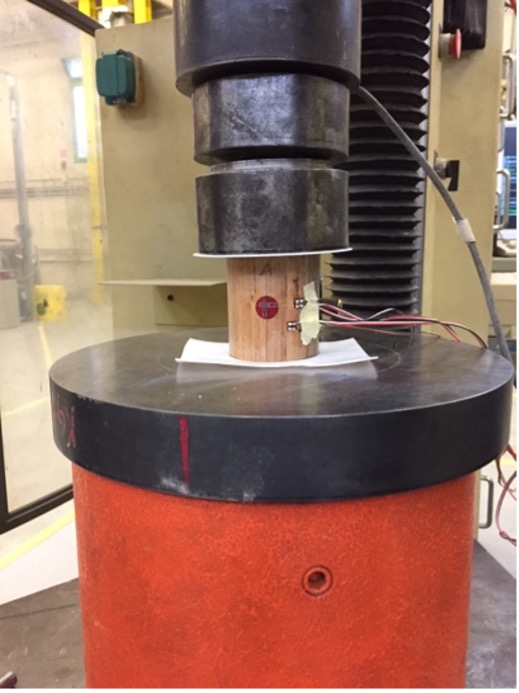

Figure 1. Set up for: (a) tension test, (b) compression test.
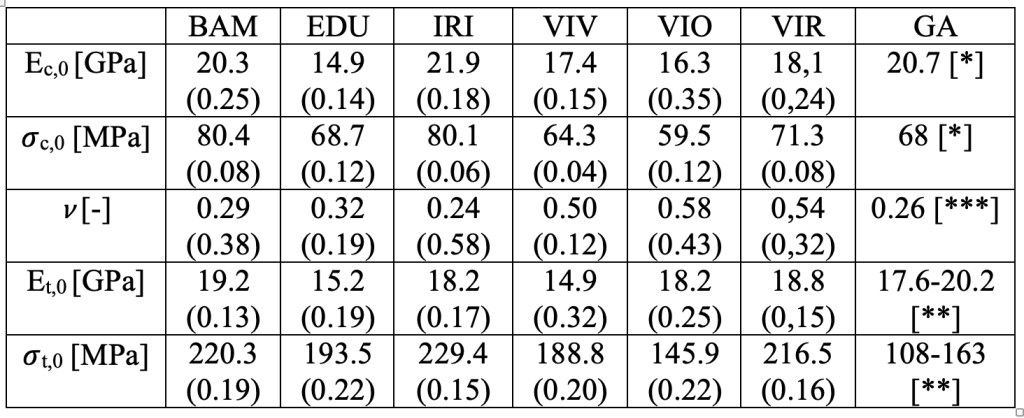
Mean values of modulus of elasticity, compression and tension strength, Poisson coefficient (in case of compression test). In parenthesis the coefficient of variation (COV) (the references reported in the Table are [*Lorenzo et al. 2020], [**Moreno et al. 2012], [***Ghavami et al., 2005]).
Inspecting Table 1 reveals that the mechanical strength and stiffness of Italian bamboo is comparable to Guadua Angustifolia (GA).
Tests in the circumferential direction
Tests were carried out to determine the strength and transverse stiffness of the different species in the direction orthogonal to the fibers considering also the variation between the internal and external parts.
The tests were carried out on specimens shaped as half ring and ‘C’ as shown in Figure 2 (a) and (b) respectively. Interested reader can refer to [Molari and Garcia, 2021].
Table 2 and 3 show the values of the circumferential modulus of elasticity and the circumferential strength in the internal and external part of the thickness, respectively. The internal circumferential strength is determined using semiring (SR), because the failure occurs in the internal part, while the external circumferential strength was determined using C-shaped specimens (C) because the failure in this case occurs on the external fibers.
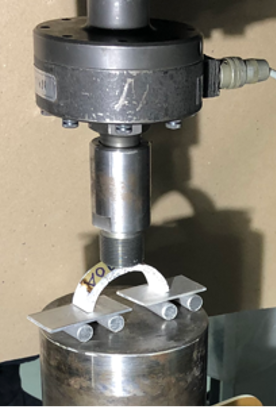
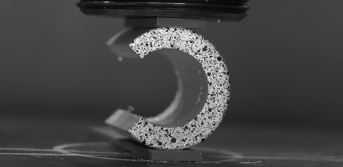
Figure 2. Tests to evaluate circumferential properties: (a) semiring specimen, (b) C shaped specimen.
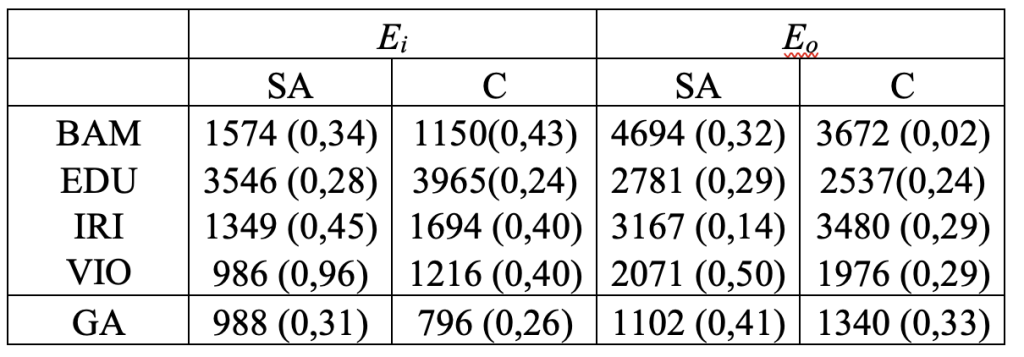

Also in this case, in the last row, the values of Guadua Angustifolia (GA) are reported for a useful comparison. It can be noted that also in the circumferential direction the values obtained with Italian bamboo are higher than those of Guadua.
Conclusions
The mechanical characteristics of various bamboo species grown in Italy (BAM, VIV and IRI in Piedmont, EDU in Friuli Venezia Giulia, VIR in Tuscany, VIO in Emilia Romagna) were evaluated in an extensive experimental campaign. The results show that the culms of Italian bamboos, despite the small size have comparable or superior mechanical characteristics in respect to tropical or subtropical bamboo.
The experience gained in the characterization of Italian bamboo at the University of Bologna led to the first Italian standard on bamboo as a structural material: UNI11842: 2021 Bamboo – Determination of the physical and mechanical properties of stalks.
References
ISO 22157:2019 Bamboo structures — Determination of physical and mechanical properties of bamboo culms
S. Greco, L. Molari, M. Marladi, ‘Full Mechanical Characterization of Phyllostachys Viridigalucescens grown in tempearture climate’, International Congress on Non-Conventional Materials NOCMAT 2019, Nairobi, Kenia, luglio 2019;
L. Molari, L. Mentrasti, M. Fabiani, ‘Mechanical characterization of five species of Italian bamboo’, Structures, 24, 59-72, 2020 (doi:10.1016/j.istruc.2019.12.022);
L. Molari, J.J. Garcia, ‘On the radial variation of the transverse mechanical properties of bamboo’, Journal of Building Engineering, 33, 101557, 2021, doi: 10.1016/j.jobe.2020.101557;
R. Lorenzo, M. Godina, L. Mimendi, H. Li, Determination of the physical and mechanical properties of moso guadua and oldhamii bamboo assisted by robotic fabrication, J Wood Sci, 66 (2020) 20. https://doi.org/10.1186/s10086-020-01869-0;
L.A. Cely Moreno, W. Geovany Hernández Rojas, O.J. Gutiérrez Junco, Caracterizacion de la Guadua Angustifolia Kunth cultivada en Miraflores (Boyac) de acuerdo con la NSR-10 The Guadua Angustifolia Kunth Grown in Miraflores (Boyac )’s Characterization, According to the NSR-10, Revista Facultad de Ingenieria, UPTC, 21:53-71, 2012;
K. Ghavami, A.B. Marinho, Propriedades físicas Propriedades físicas e mecânicas do colmo inteiro e mecânicas do colmo inteiro do bambu da espécie do bambu da espécie Guadua angustifolia
Revista Brasileira de Engenharia Agrícola e Ambiental, v.9, n.1, p.107-114, 2005 http://www.agriambi.com.br Protocolo 180 – 27/11/2002 – Aprovado em 2/4/2004.